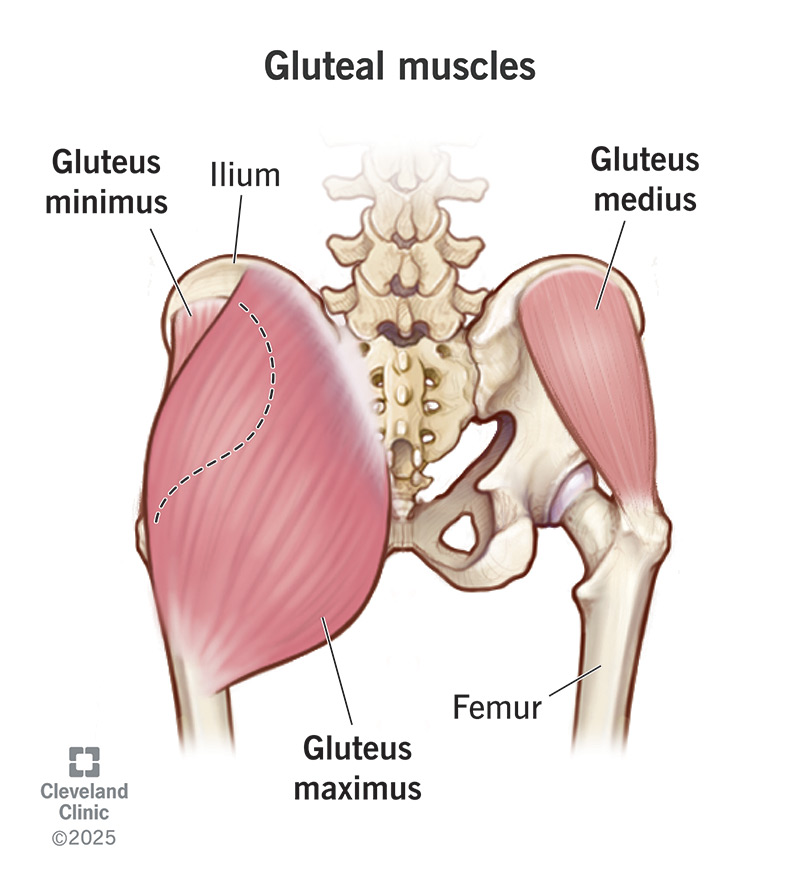Your glutes are the main muscles in your butt. You have three of them: gluteus maximus, gluteus medius and gluteus minimus. These muscles play a large role in stabilizing, balancing and controlling your lower body movements and posture. When your glutes are weak or injured, it can affect how you walk, sit and stand.
Advertisement
Cleveland Clinic is a non-profit academic medical center. Advertising on our site helps support our mission. We do not endorse non-Cleveland Clinic products or services. Policy

Your gluteal muscles (glutes) are your butt muscles. They’re at the bottom of your muscular core. They’re some of the biggest, heaviest muscles in your body.
Advertisement
Cleveland Clinic is a non-profit academic medical center. Advertising on our site helps support our mission. We do not endorse non-Cleveland Clinic products or services. Policy
You have three glute muscles:
Your glute muscles work together to help you move safely. When you’re moving, they:
You use your glutes for lots of common movements, including:
They usually work as a team, but your glutes have some individual jobs, too:
Your glutes aren’t the only muscles in your butt. But they’re the biggest and closest to the surface. They make up the shape of your butt. They’re behind your pelvis, where your spine meets your legs. They attach to your pelvis and run over and around it.
Advertisement
Your gluteus maximus muscle is the big muscle inside each of your butt cheeks. It’s closest to the surface. It starts from several points on your pelvis and wraps around your backside. It’s attached to your thigh bone. Your gluteus maximus covers part of your gluteus medius, your deep lateral hip rotators and the start of your hamstrings. If you put your hand on your butt while stepping up, you’ll feel it contract.
Your gluteus medius and gluteus minimus are both fan-shaped. Your gluteus medius muscle is deeper than your gluteus maximus. It covers the surface of your ilium, the broad bone that wraps around the sides of your hips in your pelvis. It spans your hip and attaches to the top of your thigh bone. Its back part lies under your gluteus maximus. Your gluteus minimus muscle is smaller and is under the gluteus medius. It’s the deepest of the three glutes.
Common conditions involving your glutes include:
Staying active is the best way to keep your glutes (and the rest of your musculoskeletal system) healthy.
If your daily routine includes a lot of sitting, there are a few steps (literally!) you can take to keep your glutes working like they should. Standing up, moving around during frequent breaks and a more ergonomic workstation can all help.
Specific exercises may also prevent and treat some glute issues. For example, exercises that build a strong core can help. Working with a physical therapist can be a great way to strengthen your glutes. They can prescribe specific exercises customized for your needs. You can also talk to an athletic trainer about glute exercises.
You might only think of your glute muscles when you’re sore after a workout. But you use these big muscles almost constantly throughout your day. They help you move, sit, walk and run. The best way to keep your glutes healthy is to use them. Stay active and keep moving!
Everything from sitting too long in the wrong kind of chair to injuries can cause a pain in your butt. Visit a healthcare provider if you have glute pain that doesn’t get better after a few days of rest.
Advertisement
Cleveland Clinic’s primary care providers offer lifelong medical care. From sinus infections and high blood pressure to preventive screening, we’re here for you.

Last reviewed on 03/23/2025.
Learn more about the Health Library and our editorial process.